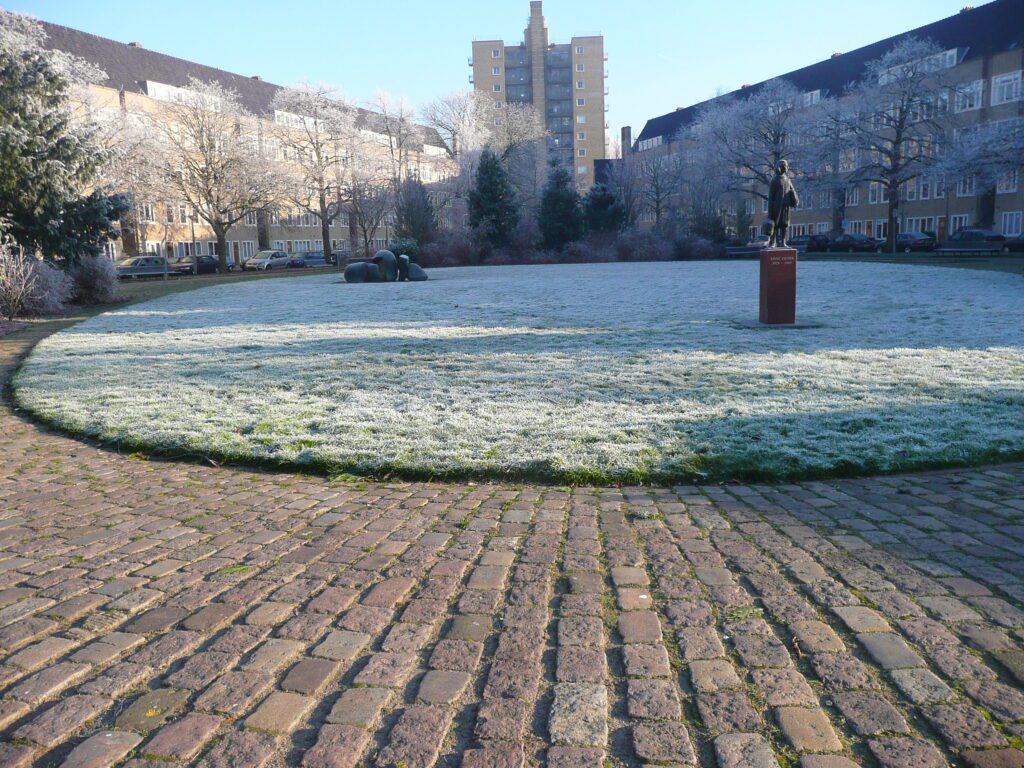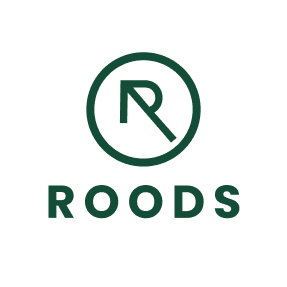Anne Frank is one of Amsterdam’s most recognised names, yet the city holds more of her world than the single, essential museum visit. If you want to understand the everyday life that preceded hiding—and the wider community that shaped it—these lesser-known places offer context in small, powerful doses. Each site is easy to reach on foot or by tram; most are ordinary buildings in living neighbourhoods, so approach with care and respect. (If you prefer to explore with short, place-based audio notes, open Roods and start here: https://web.roods.io/city/67ef713d2cd85edd3971789e.)
1) Merwedeplein 37-2 — the family home before hiding
In the Rivierenbuurt, Merwedeplein 37-2 was home to the Frank family from 1933 until 1942. Standing on the square, you sense the ordinariness that shaped Anne Frank’s early Amsterdam years: brick apartment blocks, trees, bicycles, neighbours going about their day. The building remains residential; admire it quietly from the street and look for discreet markers that note the address. This is where school mornings began, where Dutch took root as a new language, and where diary habits formed before the Annex became a necessity.
How to read the place: notice the modest scale, the shared stairwells, the rhythm of doors and windows—details of everyday security that disappeared overnight when persecution hardened.

2) Jewish Lyceum — learning under restriction
At Voormalige Stadstimmertuin 1, the Jewish Lyceum gathered students who, by 1941, were barred from other schools. Classrooms became spaces of resilience, with teachers trying to offer normal lessons under abnormal rules. Buildings and functions have shifted since the war, but the location still carries the feeling of a community trying to protect a future for its children. Seeing the site helps connect Anne Frank’s words to thousands of other young lives that were suddenly rerouted.
Visiting tip: treat the area like any active school zone—keep noise low and avoid photographing pupils or staff.
3) Montessori School (Niersstraat 41–43) — early confidence and curiosity
Before the Lyceum, Anne Frank attended a public Montessori school where the emphasis on self-directed learning matched her curiosity. The building still serves local families, and the courtyard is private. Even from the street, you can read the atmosphere: a neighbourhood school where handwriting, reading circles, and small projects shaped confidence. Thinking of Anne here grounds the global story in the ordinary rhythm of packed lunches and after-school chatter.
What to notice: name plaques, period brickwork, and the way Amsterdam integrates schools into residential blocks—education as part of street life.
4) Joods Boekhuis (Van Woustraat 135) — traces of a cultural ecosystem
While not a personal haunt we can prove, a Jewish bookshop like the Joods Boekhuis represents the cultural ecosystem that surrounded families like the Franks: ideas, newspapers, community notices, translations, children’s books. Visiting a shopfront or successor site in the old neighbourhood is a reminder that Anne Frank grew up amid a living, reading city. Browse shelves where possible, or simply note how close such places sit to schools, tram stops, and homes—the everyday mesh that persecution tried to sever.
Context clue: look for period typography, traces of old shop signs, and the density of small businesses that kept neighbourhoods stitched together.
5) National Holocaust Museum (Plantage Middenlaan) — from singular story to wider history
To understand how Anne Frank’s experience fits into the broader arc of persecution and survival in the Netherlands, visit the National Holocaust Museum. Exhibitions trace anti-Jewish measures, deportations, and acts of help and resistance across the country. Artefacts, testimonies, and careful curation move the story from one family to a national reckoning. It’s not a “hidden” site, but it is the place that holds the context the streets alone can’t provide.
How to pair it: walk a short loop in the nearby Plantage district—zoo, theatre façades, and former Jewish institutions—before or after your visit to let the neighbourhood geography sink in.
Anne Frank in Amsterdam: how to explore respectfully
These sites are part of a living city. Keep voices low, give residents privacy, and step aside on narrow pavements. Avoid ringing doorbells or photographing people in their homes. Where signage restricts entry, observe from the street. Remember that Anne Frank’s legacy belongs to a community that still lives here; your care keeps the story welcome in daily life.
Optional short route
If you want to connect a few places, pick a morning loop: start at Merwedeplein in the south, continue by tram toward the centre for the Jewish Lyceum and the Montessori school, and finish in the Plantage district at the National Holocaust Museum. Along the way, notice how ordinary distances—home to school, school to shop—frame the extraordinary decisions the Franks had to make. (For layered, on-the-spot context as you walk, open the Roods map of Amsterdam and follow stories near each stop.)
Conclusion
The museum remains essential, but Anne Frank’s Amsterdam also lives in schools, squares, shopfronts, and archives. Stand quietly at these addresses and the diary’s scenes widen: a family adapting to a new language, a classroom under new rules, a city of books and neighbours. In the end, the places that shaped the diary are not only famous—they’re woven through the everyday streets you’re walking now.
Further reading & official resources:
Anne Frank House — biography, timelines, primary sources — https://www.annefrank.org/en/
Anne Frank House — visiting information — https://www.annefrank.org/en/museum/tickets/
Stadsarchief Amsterdam — city archives & historic images — https://archief.amsterdam
National Holocaust Museum (Amsterdam) — exhibitions & context — https://www.nationaalholocaustmuseum.nl/en
NIOD Institute for War, Holocaust and Genocide Studies — https://www.niod.nl/en
Jewish Cultural Quarter (Portuguese Synagogue, Jewish Museum, Hollandsche Schouwburg) — https://jck.nl/en
National Holocaust Names Memorial (Monument with victims’ names) — https://www.holocaustnamenmonument.nl/en

